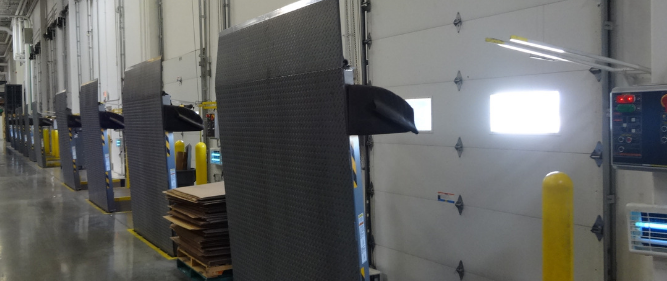When it comes to designing loading docks for today’s food and beverage manufacturing facilities, there are two main choices when it comes to dock levelers: ones that store horizontally and ones that store vertically.
Pit, or recessed, dock levelers store horizontally and are the most commonly found across all industries. This traditional style of leveler has been around for decades and is used in a variety of facilities.
Vertical storing dock levelers have emerged as a newer alternative to pit levelers, and they are a better choice for food and beverage facilities and refrigerated warehouses. They are hydraulic powered and stand upright inside the building when not in use.
Which option is best for your facility? If you are a food or beverage processor, a vertical leveler is likely your best bet. Let’s look at the advantages and disadvantages of this equipment to understand why.
Benefits of vertical loading dock levelers
There are several reasons I recommend vertical storing dock levelers to owners of food and beverage processing facilities:
1. Easier to keep clean — If a box or bag opens and spills product while on a pit dock leveler, the new mess can fall in the gaps between the leveler and concrete and can be difficult to access. The design of a vertical storing dock leveler makes it easier to clean the pit below (and deter pests), which is critical for maintaining food safety.
2. Increased worker safety — Vertically stored levelers create a barrier between the dock and the fork truck area, which minimizes accidents by preventing fork trucks from getting caught in between.
3. Improved seal of dock door — It’s difficult to fully seal the dock door with a pit leveler, meaning pests and outside air can more easily enter the building. Vertical levelers allow the overhead door to remain closed and tightly sealed, which is especially important for refrigerated facilities and to reduce food contamination risks.
4. More efficient trailer docking — With a pit leveler, the truck driver must exit the vehicle and open the trailer doors before backing into the building, exposing the contents of the trailer to the environment (warm air, airborne contaminants, insects, birds). A vertically stored leveler is typically used in combination with a dock shelter, meaning the truck driver can stay in the cab and simply back into the building. A dock attendant can open the trailer doors later, when it’s time to unload, leaving the trailer sealed when not in use. This process is safer and more efficient.
5. Easier maintenance — Generally, vertical levelers are easier to maintain than their horizontal counterparts. Given the orientation of a vertical leveler when stored, it’s easier for maintenance personnel to access the “guts” of the leveler when something needs to be examined or repaired. A pit-style leveler needs to be raised and accessed from outside, meaning weather conditions could impede maintenance.
Disadvantages of vertical loading dock levelers
The two most common issues some owners have with vertical loading dock levelers are cost and space.
Vertical dock levelers are hydraulic powered, and they can be more complex and more expensive than traditional pit levelers. While this is a deciding factor for many facility owners outside the food industry, more food companies are opting to invest in vertical levelers given their food safety benefits.
Vertical levelers are often paired with dock shelters, rather than dock seals, to allow trailers to back into the building’s interior and provide unobstructed access to the load. By design, these shelters require the dock doors to be spaced out more, meaning less total dock positions overall. Therefore, owners who want to maximize the number of dock doors in their facility may opt for traditional pit levelers.
Should Your Food Plant Use Vertical Loading Dock Levelers?
Given the pros and cons of vertical loading dock levelers, are they worth the investment? If you are building or renovating a food or beverage facility, my answer would be yes.
Stellar designs and constructs numerous food manufacturing plants, cold storage warehouses and processing facilities each year, and there’s a reason we’ve seen an increasing demand for vertical loading dock levelers. They’re a safe, efficient and ideal solution for facilities looking to conserve energy, maximize efficiency and prioritize food safety.
Have questions about the right equipment for your loading dock? Need help planning and designing your next facility? Feel free to email me your questions at foodforthought@stellar.net or give us a call at 904-260-2900.




Hi , How much will be the changing cost for Pit Dock Leveler to Vertical Dock Leveler. Thanks, Deepika
Hi Deepika. Thanks for your question. For vertical style levelers, dock equipment would typically be about $28,000 per position including the leveler, dock restraint, dock shelter, bumpers, controls and light. A similar set up for the pit style leveler would cost about $25,000 per position for the dock equipment.
Also, the vertical style levelers require bollards at the edge of the pit, so the construction cost of a vertical lever will be roughly $5,000 more per dock position than the pit style leveler. Thanks!